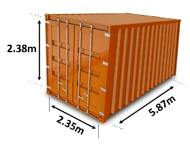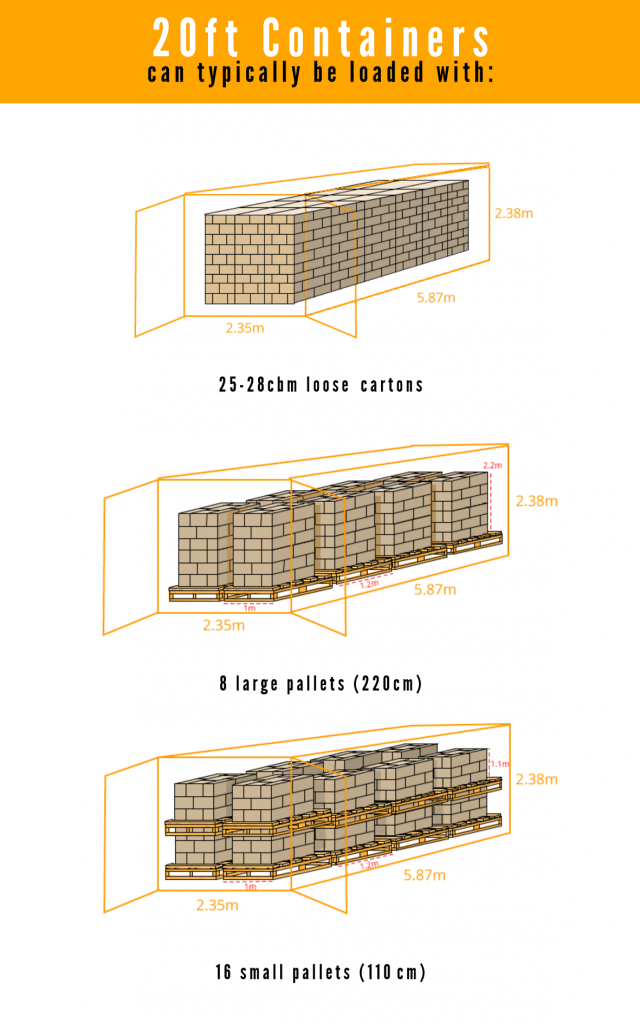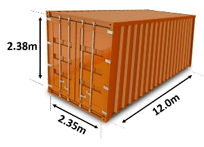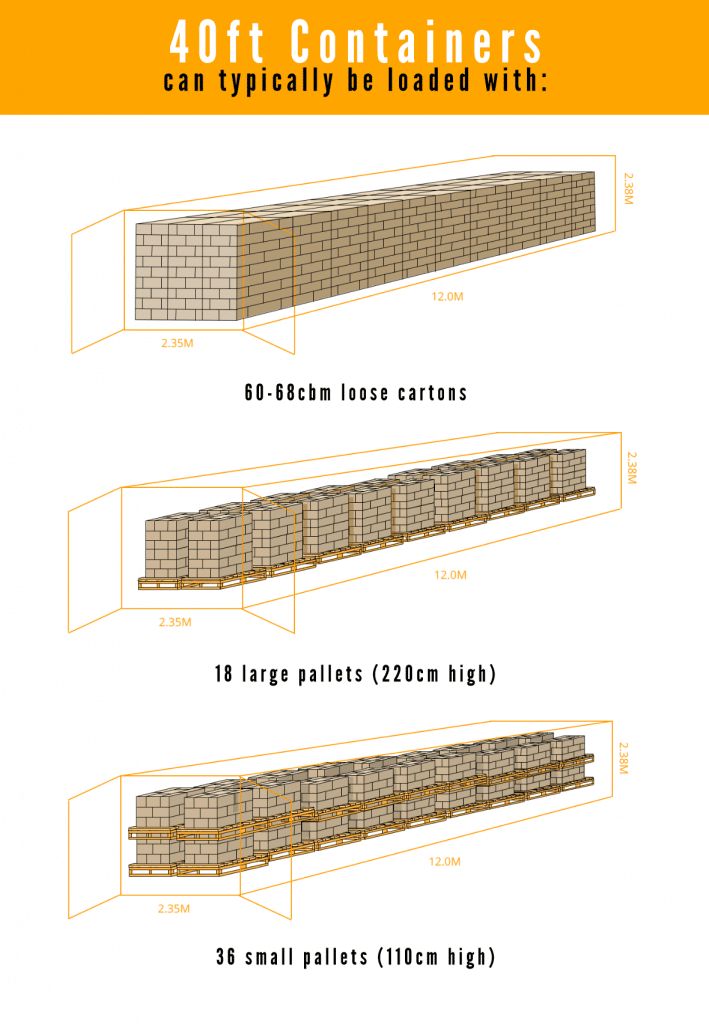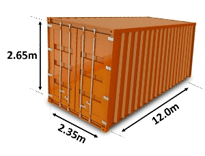If you’re shipping enough goods to fill a container then you’ll need to arrange an FCL (Full Container Load) shipment.
The most common containers in circulation are currently dry storage, general purpose containers, which come in the standard 20ft, 40ft and 40ft High Cube (often shortened to HC or HQ) sizes. These are used to ship dry goods and are what most importers will use.
-
Shipping Containers | Sizes and Types
It’s generally a good idea to use the container sizes as consideration for the volume of goods that you’re purchasing. If you purchase goods only to find out that they’re a few cubic meters over capacity, you’ll need to pay for a bigger container – and nobody wants that!
Remember that a full container will be delivered as a container on the back of a lorry – it will be your responsibility to get the goods out of the container and onto your premises so make sure you have extra hands available on the day to assist… Here’s how your goods will be delivered.
If your goods are an odd shape, or are extremely heavy, you should check with your supplier how they generally load their goods and more importantly, what fits into a container. They should have plenty of experience in loading their goods into containers so you should generally be led by them, however, here’s our guide to what you can fit into those big metal boxes.
-
How Much Can I Fit In A 20ft Container?
A 20ft container (20ft in length) can generally squeeze about 25-28cbm worth of goods inside. This is massively dependent on the nature of the goods as some commodities won’t be able to stack and some boxes are too large to fit in efficiently. You can often load over 15,000kg without incurring a ‘heavy weight surcharge’.
- Dimensions of a 20ft container : 2.38m x 2.35m x 5.87m
- Fresh air in a 20ft container : 33cbm
- Cartons in a 20ft container : 25-28cbm of cartons (possibly less if very large cartons – more wasted space; possibly more if fairly small cartons – less wasted space)
- Pallets in a 20ft container : 8 pallets (if the pallets are up to 220cm tall, or 16 pallets double stacked pallets of around 110cm tall).
Don’t forget if you have large items there will be a lot of unusable space so you should ask your supplier before assuming you can get 28cbm of goods into a 20ft container.
-
How Much Can I Fit In a 40ft Container?
As you’d expect, a 40ft container has the capacity of around double a 20ft container. A 40ft container (40ft in length) can generally squeeze about 54-58cbm worth of goods inside. Again, this is dependent on the nature of the goods and the size of the cartons. You can often load over 20,000kg without incurring a ‘heavy weight surcharge’.
- Dimensions of a 40ft container : 2.38m x 2.35m x 12m
- Fresh air in a 40ft container : 67cbm
- Cartons in a 40ft container : 54-58cbm of cartons (possibly less if very large cartons – more wasted space; possibly more if fairly small cartons – less wasted space)
- Pallets in a 40ft container : 18 pallets (if the pallets are up to 220cm tall, or 36 pallets double stacked pallets of around 110cm tall).
-
How Much Can I Fit In a 40ft High Cube Container?
If you’re trying to import as much as is physically possible then the 40ft High Cube container is for you! The only difference in dimensions between a 40ft and a 40ft High Cube is that there is a little added height, which can often allow you an extra row of goods. Although only a 27cm height increase, this adds up to a total extra volume of 9cbm!
- Still 40ft in length but taller at 2.65m in height
- Internal dimensions of 2.65m x 2.35m x 12.0m
- Can hold 76 cbm (cubic metres) of air
- Assume 60-68 cbm of your goods will fill one (if boxed)
A 40ft High Cube (also known as 40ft HC or 40ft HQ) is the king of the containers and is the largest that is currently being used routinely by the shipping lines. Inside a 40ft HC you can fit 60-68cbm of stackable goods. Again, ask your supplier for confirmation about how many of the products that you’re ordering will fit.
-
Do I Need to Buy a Shipping Container?
A lot of people call us to enquire about the cost of shipping containers, “can we buy a container in China, import goods in it and keep it?” – and some even ask us whether we can sell them one. (In case you’re wondering . . . no, no, we can’t.)
Now, unless you’re planning to build a beautiful house using shipping containers, the likelihood is that you don’t actually need a container at all. If you want to buy a container to store your goods then you’ll probably have to do that separately, moving the goods you import into it, as shipping lines don’t sell containers that they’re using. Some people even think that they need to purchase a container to load their goods into for transportation, but they don’t. Repeat:
You do not need to buy a shipping container to import via sea freight.
The shipping lines provide and own shipping containers for all their customers. The container is normally driven to your supplier where the goods are loaded. From there, the container is taken to the port, sup on a vessel and shipped to the port of destination before, whilst still in the container, delivered to your door on the back of a truck. You’ll have 3 hours to unload the goods from the container, either by hand or by fork-lift (if you have access to one) before the lorry driver takes the empty container back to the port for the process to restart. You do not need to purchase a shipping container – and you don’t get to keep the container either. (Yes, we have had people asking if they could keep the gigantic metal box.)
In fact, buying a shipping container would put you out of pocket because you’d have to invest thousands just to buy one (not to mention the cost of transportation and lowering it to the floor) when shipping lines provide it as part of the service.
Now, if you really want to buy a shipping container, you’ll usually have to buy it secondhand and it will typically cost you upwards of £1,000. Many different companies offer shipping containers with a variety of options such as repainting, anti-condensation treatment and sometimes even electrical fittings.
-
Get a Quote
If you’d like to get a quote to ship your goods whether that be a full container or a less than container load, feel free to get in touch with us.
We’re happy to answer any questions and our approachable team will hold your hand throughout the process.

